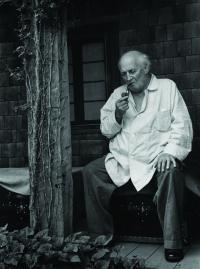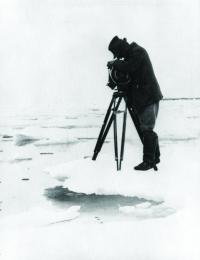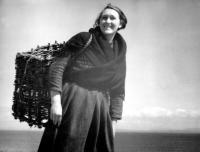Man of Aran
Published in 20th Century Social Perspectives, 20th-century / Contemporary History, Issue 2(March/April 2011), Reviews, Volume 19
Robert Flaherty—comes across as a condescending and domineering personality, unwilling to relinquish his grip on the vision he sought to portray. (Yale)
Robert Flaherty’s 1934 docu-drama Man of Aran was recently included in IMMA’s remarkable exhibition The Moderns. This decision was unlikely to have been prompted by the subject-matter alone, for the film has a twofold significance. In Irish terms, Man of Aran is indeed a unique visual depiction of life on the Aran Islands in the early twentieth century. But in international terms it is also a key work in the canon of the man who, perhaps more than any other, invented the documentary as we know it today: Robert Flaherty (1884–1951), whose life and career was the subject of Mac Dara Ó Curraidhín’s ambitious and engrossing film.
Flaherty was of German–Irish extraction and was born in the Michigan mining town of Iron Mountain—an appropriately rugged name, given his later career. He was something of an autodidact; as a young man he followed his father into mining, and in the course of prospecting began to experiment with photography (this ultimately led to his election to the Royal Geographical Society). Having married into money, he eventually expanded his range into moving pictures, but did so in an unstructured manner. As he put it himself, he was simply filming ‘scenes of this’ and ‘scenes of that’. But Edmund Curtis’s charmingly titled In the land of the headhunters (1915), which was essentially a Western in lurid garb, seems to have provided Flaherty with a model for a particular type of film. As a prospector, Flaherty had had considerable dealings with the Inuit of northern Canada. He obtained the backing of a fur company, went to Canada, and in 1921 announced himself to the world with the massively successful Nanook of the North.

Flaherty filming Nanook of the North in 1921 in Canada. (Clermont)
This was the simple tale of the travails of an Inuit family, built around a hunting trip and billed as an authentic depiction of an actual family struggling to survive in the primeval wilderness of the Arctic. To a world reeling from the Great War, and to a cinema-going public appalled by the decadence of Hollywood (the Fatty Arbuckle scandal had recently broken), the image of innocent, pre-modern simplicity presented by Flaherty had an undeniable appeal. But was this anything more than just an image? Nanook of the North is regarded as a seminal film in the development of the documentary, but it also posed a question that would follow Flaherty on his travels across the world: how much of what he filmed was real? Flaherty had, after all, deliberately cast the members of the family, employed considerable sleight of hand in the course of filming, and went to great lengths to keep the modern world—with which the Inuit were very familiar—literally out of the picture. The image of Inuit life that he presented as contemporary was that of previous generations. For example, the obvious tool with which to hunt a walrus on a beach in the 1920s was a gun, but using a harpoon made better ‘copy’ (in the relevant scene a gun is clearly visible to the side—a sensible precaution). If such things had been fabricated, how could Flaherty’s film be trusted? It brings to mind William Randolph Hearst’s apocryphal telegram to a journalist in search of a conflict: that if he provided the pictures, Hearst would provide the war. Such questions can be (and often are) applied to much of Flaherty’s body of work. But that should not obscure the fact that he was a pioneer in a particular form of film-making. The successor to Nanook of the North was Moana (1925), filmed in Samoa and reviewed by the Scottish journalist and film-maker John Grierson, who coined the term ‘documentary’ to describe it.

Man of Aran depicts the life of a family on the island, hewing a stark living from the bleak wilderness in which they dwelt. As a depiction of island life, Flaherty’s film can be considered alongside the writings of J.M. Synge and, more recently, Tim Robinson. (Robert Grant)
Flaherty never quite fitted into the studio system: his maverick and leisurely working methods continually exasperated his backers, so in the 1930s Grierson recruited him to make educational films for the British government. Little came of this, but it opened the door to the filming of Man of Aran. As a depiction of island life, Flaherty’s film can be considered alongside the writings of J.M. Synge and, more recently, Tim Robinson; indeed, it has become a staple fixture for the tourist industry of the islands. It depicts the life of a family on the island, hewing a stark living from the bleak wilderness in which they dwelt. There were obvious parallels with his earlier work, especially in his manipulation of reality: the notorious staging of the long-abandoned shark hunt, and his insistence that islanders speak English rather than their native Irish (ironically, Flaherty had been the first to capture spoken Irish on-screen, in the now lost Oiche Seanchais). He also continued to indulge in an appalling willingness to endanger the lives of his cast as he sought to frame their existence against the grandeur of the elements. Flaherty comes across as a condescending and domineering personality, unwilling to relinquish his grip on the vision he sought to portray; he even insisted that the cast, while on a publicity tour, wear nothing but their usual island garb. But there can be no denying that the footage was extraordinary: Man of Aran won best film at the Venice Film Festival in 1935.
Flaherty never quite scaled these heights again. He won an Oscar in 1950, but for a German documentary that he had distributed. A consummate showman (and lifelong denizen of the Chelsea Hotel), his life would warrant a drama in itself. He pioneered a ubiquitous format. But should his own work be viewed with scepticism? Some wariness is appropriate. ‘Reconstructions’ are part and parcel of modern documentaries, and while this is essentially what Flaherty had done, he deliberately never made any clear distinction between reality and reconstruction. But his images are not without value. In the course of this excellent documentary, illustrated as it was with copious footage from Flaherty’s works, the film-makers canvassed the opinions of contemporary Inuits and Samoans about the manner in which he depicted the lifestyles of their ancestors. They viewed Nanook of the North and Moana in broadly favourable terms, and as reasonably accurate. A cynic might say that this was proof of Flaherty’s ability to hoodwink his audience; after all, Coleman ‘Tiger’ King, who played the eponymous man of Aran, later said that the film was ‘bullshit’. There can be no denying that Robert Flaherty engaged in a considerable degree of myth-making. But given that some definitions of myth suggest that part of their purpose is to convey an essential truth, Flaherty may have gotten some things right along the way. HI
















